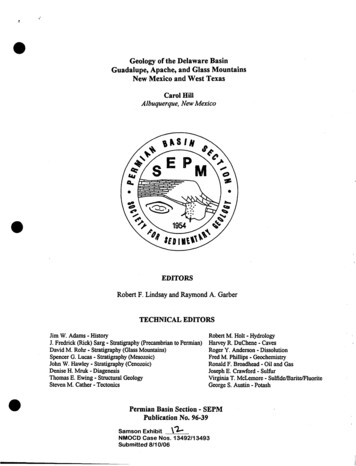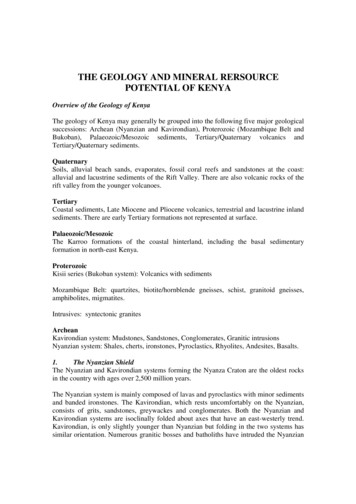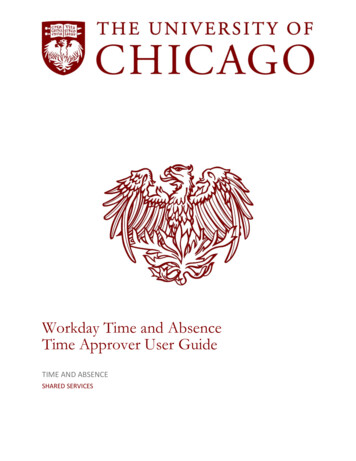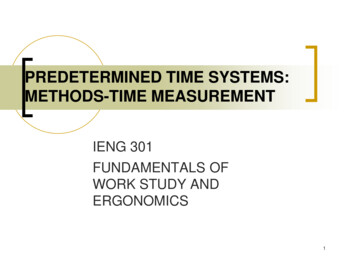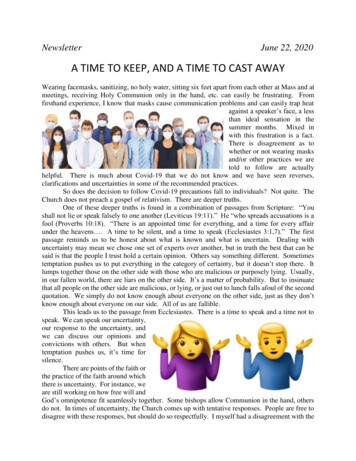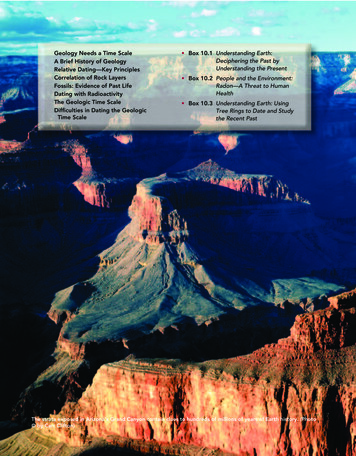
Transcription
Geology Needs a Time ScaleA Brief History of GeologyRelative Dating—Key PrinciplesCorrelation of Rock LayersFossils: Evidence of Past LifeDating with RadioactivityThe Geologic Time ScaleDifficulties in Dating the GeologicTime Scale Box 10.1 Understanding Earth:Deciphering the Past byUnderstanding the Present Box 10.2 People and the Environment:Radon—A Threat to HumanHealth Box 10.3 Understanding Earth: UsingTree Rings to Date and Studythe Recent PastThe strata exposed in Arizona’s Grand Canyon contain clues to hundreds of millions of years of Earth history. (Photo by Carr Clifton)
Geologic TimeC H A P T E R10285UNIT 4: DECIPHERINGEARTH’S HISTORY
286 Unit Four Deciphering Earth’s Historyn the eighteenth century, James Hutton recognized the immensity of Earth history and the importance of time as a component in all geologicalprocesses. In the nineteenth century, others effectively demonstrated that Earth had experienced many episodes of mountain building and erosion,which must have required great spans of geologic time.Although these pioneering scientists understood thatEarth was very old, they had no way of knowing its trueage. Was it tens of millions, hundreds of millions, oreven billions of years old? Rather, a geologic time scalewas developed that showed the sequence of eventsbased on relative dating principles. What are these principles? What part do fossils play? With the discoveryof radioactivity and the development of radiometricdating techniques, geologists now can assign fairly accurate dates to many of the events in Earth history.What is radioactivity? Why is it a good “clock” for dating the geologic past? In this chapter we shall answerthese questions.IGeology Needs a Time ScaleIn 1869 John Wesley Powell, who was later to head theU.S. Geological Survey, led a pioneering expeditiondown the Colorado River and through the GrandCanyon (Figure 10.1). Writing about the rock layers thatwere exposed by the downcutting of the river, Powellsaid that “the canyons of this region would be a Book ofA.Revelations in the rock-leaved Bible of geology.” Hewas undoubtedly impressed with the millions of yearsof Earth history exposed along the walls of the GrandCanyon (see chapter-opening photo).Powell realized that the evidence for an ancientEarth is concealed in its rocks. Like the pages in a longand complicated history book, rocks record the geological events and changing life forms of the past. Thebook, however, is not complete. Many pages, especially in the early chapters, are missing. Others are tattered,torn, or smudged. Yet enough of the book remains toallow much of the story to be deciphered.Interpreting Earth history is a prime goal of the science of geology. Like a modern-day sleuth, the geologistmust interpret clues found preserved in the rocks. Bystudying rocks, especially sedimentary rocks, and thefeatures they contain, geologists can unravel the complexities of the past.Geological events by themselves, however, have little meaning until they are put into a time perspective.Studying history, whether it be the Civil War or the Ageof Dinosaurs, requires a calendar. Among geology’smajor contributions to human knowledge is the geologic time scale and the discovery that Earth history is exceedingly long.The geologists who developed the geologic timescale revolutionized the way people think about timeand how they perceive our planet. They learned thatEarth is much older than anyone had previously imagined and that its surface and interior have been changedB.Figure 10.1 A. Start of the expedition from Green River station. A drawing from Powell’s 1875 book. B. Major John Wesley Powell,pioneering geologist and the second director of the U.S. Geological Survey. (Courtesy of the U.S. Geological Survey, Denver)
Chapter 10over and over again by the same geological processesthat operate today.A Brief History of GeologyBOX 10.1In the mid-1600s, James Ussher, Anglican Archbishopof Armagh, Primate of all Ireland, published a work thathad immediate and profound influence on people’s viewof Earth’s age. A respected scholar of the Bible, Ussherconstructed a chronology of human and Earth historyin which he determined that Earth was only a few thousand years old, having been created in 4004 B.C. Ussher’streatise earned widespread acceptance among Europe’sscientific and religious leaders, and his chronology wassoon printed in the margins of the Bible itself.During the seventeenth and eighteenth centuriesthe doctrine of catastrophism strongly influenced people’s thinking about Earth. Briefly stated, catastrophistsbelieved that Earth’s landscapes had been developedprimarily by great catastrophes. Features such as mountains and canyons, which today we know take great periods of time to form, were explained as having beenproduced by sudden and often worldwide disasterstriggered by unknowable causes that no longer operate. This philosophy was an attempt to fit the rate ofGeologic Time287Earth processes to the prevailing ideas on the age ofEarth.Birth of Modern GeologyModern geology began in the late 1700s when JamesHutton, a Scottish physician and gentleman farmer,published his Theory of the Earth. In this work, Huttonput forth a fundamental principle that is a pillar of geology today: uniformitarianism. It simply states thatthe physical, chemical, and biological laws that operate todayhave also operated in the geologic past. This means that theforces and processes that we observe presently shapingour planet have been at work for a very long time. Thus,to understand ancient rocks, we must first understandpresent-day processes and their results. This idea iscommonly expressed by saying “the present is the keyto the past” (see Box 10.1).Prior to Hutton’s Theory of the Earth, no one had effectively demonstrated that geological processes occurover extremely long periods of time. However, Huttonpersuasively argued that weak, slow-acting processescould, over long spans of time, produce effects just asgreat as those resulting from sudden catastrophicevents. Unlike his predecessors, Hutton carefully citedverifiable observations to support his ideas.UNDERSTANDING EARTH:Deciphering the Past byUnderstanding the PresentLouis Agassiz, aSwiss scientistborn in 1807, was instrumental in formulating modern ideas about the IceAge (Figure 10.A). The development ofthis knowledge provides an excellentexample of the application of the principle of uniformitarianism.In 1821 Agassiz heard another scientist present a paper in which he indicated that glacial features occurred inplaces that were a significant distancefrom existing glaciers in the Alps. This,of course, implied that the glaciers hadonce occupied areas considerably beyond their present limits. Agassiz wasskeptical about this hypothesis and setout to invalidate it. Ironically, his fieldwork in the Alps convinced him of themerits of his colleague’s hypothesis.Agassiz found the same unique de-posits and features that can be seenforming in association with active glaciers in places far beyond the limits ofthe ice. Subsequent work led Agassiz tohypothesize that a great ice age had occurred in response to a period of worldwide climate change and had affectedlarge parts of the globe. Agassiz’s ideaseventually developed into our presentday glacial theory.The proof of the glacial theory proposed by Agassiz and others constitutesa classic example of applying the principle of uniformitarianism. Realizingthat certain landforms and other features are produced by no other knownprocess but glacial activity, they wereable to reconstruct the extent of nowvanished ice sheets. Clearly, understanding the present was the key to deciphering the past.Figure 10.A Louis Agassiz (1807–1873)played a major role in the development ofglacial theory. (Courtesy of HarvardUniversity Archives)
288 Unit Four Deciphering Earth’s HistoryToday the basic tenets of uniformitarianism are just as viable as in Hutton’s day. Indeed, we realize more strongly than ever that the present gives us insight into thepast and that the physical, chemical, and biological lawsthat govern geological processes remain unchangingthrough time. However, we also understand that thedoctrine should not be taken too literally. To say that geological processes in the past were the same as those occurring today is not to suggest that they always had thesame relative importance or that they operated at precisely the same rate. Moreover, some important geologic processes are not currently observable, but evidencethat they occur is well established. For example, weknow that Earth has experienced impacts from large meteorites even though we have no human witnesses. Suchevents altered Earth’s crust, modified its climate, andstrongly influenced life on the planet.The acceptance of uniformitarianism meant the acceptance of a very long history for Earth. AlthoughEarth’s processes vary in intensity, they still take a verylong time to create or destroy major landscape features.For example, geologists have established thatmountains once existed in portions of present-day Minnesota, Wisconsin, and Michigan. Today the regionconsists of low hills and plains. Erosion gradually destroyed these peaks. Estimates indicate that the NorthAmerican continent is being lowered at a rate of about3 centimeters per 1000 years. At this rate, it would take100 million years for water, wind, and ice to lowermountains that were 300 meters (10,000 feet) high.But even this time span is relatively short on thetime scale of Earth history, for the rock record containsevidence that shows Earth has experienced many cycles of mountain building and erosion. Concerning theever changing nature of Earth through great expansesof geologic time, Hutton made a statement that was tobecome his most famous. In concluding his classic 1788paper published in the Transactions of the Royal Society ofEdinburgh, he stated, “The results, therefore, of our present enquiry is, that we find no vestige of a beginning—no prospect of an end.”It is important to remember that although manyfeatures of our physical landscape may seem to be unchanging over our lifetimes, they are neverthelessGeologic TimeRelative DatingNTHCERelative Dating—Key PrinciplesRGeology Todaychanging, but on time scales of hundreds, thousands,or even many millions of years.EAFor example, when he argued that mountains aresculpted and ultimately destroyed by weathering andthe work of running water, and that their wastes arecarried to the oceans by processes that can be observed,Hutton said, “We have a chain of facts which clearlydemonstrates that the materials of the wasted mountains have traveled through the rivers”; and further,“There is not one step in all this progress that is not tobe actually perceived.” He then went on to summarizethis thought by asking a question and immediately providing the answer: “What more can we require? Nothing but time.”SCIEDuring the late 1800s and early 1900s, various attemptswere made to determine the age of Earth. Althoughsome of the methods appeared promising at the time,none proved reliable. What these scientists were seeking was a numerical date. Such dates specify the actual number of years that have passed since an eventoccurred—for example, the extinction of the dinosaursabout 65 million years ago. Today our understanding ofradioactivity allows us to accurately determine numerical dates for rocks that represent important events inEarth’s distant past. We will study radioactivity later inthis chapter. Prior to the discovery of radioactivity, geologists had no accurate and dependable method of numerical dating and had to rely solely on relative dating.Relative dating means placing rocks in their proper sequence of formation—which ones formed first, second, third, and so on. Relative dating cannot tell us howlong ago something took place, only that it followed oneevent and preceded another. The relative dating techniques that were developed are valuable and still widely used. Numerical dating methods did not replace thesetechniques; they simply supplemented them. To establish a relative time scale, a few basic principles or ruleshad to be discovered and applied. Although they mayseem obvious to us today, they were major breakthroughs in thinking at the time, and their discovery andacceptance was an important scientific achievement.?STUDENTS SOMETIMES ASK.You mentioned early attempts atdetermining Earth’s age thatproved unreliable. How didnineteenth-century scientists goabout making such calculations?One method that was attempted several times involved therate at which sediment is deposited. Some reasoned that ifthey could determine the rate that sediment accumulates andcould further ascertain the total thickness of sedimentary rockthat had been deposited during Earth history, they could estimate the length of geologic time. All that was necessary wasto divide the rate of sediment accumulation into the totalthickness of sedimentary rock.Estimates of Earth’s age varied each time this method wasattempted. The age of Earth as calculated by this methodranged from 3 million to 1.5 billion years! Obviously thismethod was riddled with difficulties. Can you suggest whatsome might have been?
Chapter 10Law of SuperpositionNicolaus Steno, a Danish anatomist, geologist, andpriest (1636–1686), is credited with being the first to recognize a sequence of historical events in an outcrop ofsedimentary rock layers. Working in the mountains ofwestern Italy, Steno applied a very simple rule that hascome to be the most basic principle of relative dating—the law of superposition. The law simply states that inan undeformed sequence of sedimentary rocks, eachbed is older than the one above it and younger than theone below. Although it may seem obvious that a rocklayer could not be deposited unless it had somethingolder beneath it for support, it was not until 1669 thatSteno clearly stated the principle.This rule also applies to other surface-deposited materials, such as lava flows and beds of ash from volcaniceruptions. Applying the law of superposition to the bedsexposed in the upper portion of the Grand Canyon (Figure 10.2), you can easily place the layers in their properorder. Among those that are shown, the sedimentaryrocks in the Supai Group must be the oldest, followed inorder by the Hermit Shale, Coconino Sandstone,Toroweap Formation, and Kaibab Limestone.Principle of Original HorizontalitySteno is also credited with recognizing the importanceof another basic principle, called the principle of original horizontality. Simply stated, it means that layers ofsediment are generally deposited in a horizontal position. Thus, if we observe rock layers that are flat, itmeans they have not been disturbed and thus still havetheir original horizontality. The layers in the GrandCanyon illustrate this in the chapter-opening photo andGeologic Timein Figure 10.2. But if they are folded or inclined at asteep angle, they must have been moved into that position by crustal disturbances sometime after their deposition (Figure 10.3).Principle of Cross-CuttingRelationshipsWhen a fault cuts through other rocks, or when magmaintrudes and crystallizes, we can assume that the faultor intrusion is younger than the rocks affected. Forexample, in Figure 10.4, the faults and dikes clearlymust have occurred after the sedimentary layers weredeposited.This is the principle of cross-cutting relationships.By applying the cross-cutting principle, you can see thatfault A occurred after the sandstone layer was deposited, because it “broke” the layer. However, fault A occurred before the conglomerate was laid down, becausethat layer is unbroken.We can also state that dike B and its associated sillare older than dike A, because dike A cuts the sill. In thesame manner, we know that the batholith was emplacedafter movement occurred along fault B, but before dikeB was formed. This is true because the batholith cutsacross fault B, and dike B cuts across the batholith.InclusionsSometimes inclusions can aid the relative datingprocess. Inclusions are pieces of one rock unit that arecontained within another. The basic principle is logicaland straightforward. The rock mass adjacent to the onecontaining the inclusions must have been there first inorder to provide the rock fragments. Therefore, the rockToroweap FormationYoungerKaibab LimestoneCoconino SandstoneHermit ShaleSupai GroupA.289B.Figure 10.2 Applying the law of superposition to these layers exposed in the upper portion of the Grand Canyon, the SupaiGroup is oldest and the Kaibab Limestone is youngest. (Photo by E. J. Tarbuck)
Figure 10.3 Most layers of sedimentare deposited in a nearly horizontalposition. Thus, when we see rock layersthat are folded or tilted, we canassume that they must have beenmoved into that position by crustaldisturbances after their deposition.These folded layers are exposed in theNamib Desert (southwestern Africa).(Photo by Michael Fogden/DRK Photo)mass containing inclusions is the younger of the two.Figure 10.5 provides an example. Here the inclusionsof intrusive igneous rock in the adjacent sedimentarylayer indicate that the sedimentary layer was depositedon top of a weathered igneous mass rather than beingintruded from below by magma that later crystallized.Unconformitiesunconformity represents a long period during whichdeposition ceased, erosion removed previously formedrocks, and then deposition resumed. In each case upliftand erosion are followed by subsidence and renewedsedimentation. Unconformities are important featuresbecause they represent significant geologic events inEarth history. Moreover, their recognition helps us identify what intervals of time are not represented by strataand thus are missing from the geologic record.The rocks exposed in the Grand Canyon of the Colorado River represent a tremendous span of geologic history. It is a wonderful place to take a trip through time.The canyon’s colorful strata record a long history of sedimentation in a variety of environments—advancingseas, rivers and deltas, tidal flats, and sand dunes. Butthe record is not continuous. Unconformities representWhen we observe layers of rock that have been deposited essentially without interruption, we call them conformable. Particular sites exhibit conformable bedsrepresenting certain spans of geologic time. However, noplace on Earth has a complete set of conformable strata.Throughout Earth history, the deposition of sediment has been interrupted again and again. All suchbreaks in the rock record are termed unconformities. AnFigure 10.4 Cross-cuttingrelationships are an important principleused in relative dating. An intrusiverock body is younger than the rocks itintrudes. A fault is younger than therock layers it cuts.ConglomerateShaleSanBatholithdstoneSillFault ADike BDike A290Fault B
Chapter 10291An angular unconformity indicates that during thepause in deposition, a period of deformation (foldingor tilting) and erosion occurred (Figure 10.7).When James Hutton studied an angular unconformity in Scotland more than 200 years ago, it was clearto him that it represented a major episode of geologic activity (Figure 10.7E). He also appreciated the immensetime span implied by such relationships. When a companion later wrote of their visit to the site, he stated that“the mind seemed to grow giddy by looking so far intothe abyss of time.”Intrusive igneousrockA. Intrusiveigneous rockDisconformity. When contrasted with angular unconformities, disconformities are more common, butusually far less conspicuous because the strata on eitherside are essentially parallel. For example, look at thedisconformities in the cross section of the Grand Canyon in Figure 10.6. Many disconformities are difficult toidentify because the rocks above and below are similarand there is little evidence of erosion. Such a breakoften resembles an ordinary bedding plane. Other disconformities are easier to ide
mulating modern ideas about the Ice Age (Figure 10.A). The development of this knowledge provides an excellent example of the application of the prin-ciple of uniformitarianism. In 1821 Agassiz heard another sci-entist present a paper in which he indi-cated that glacial fea

